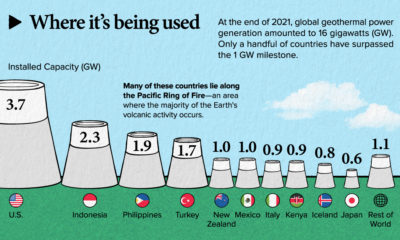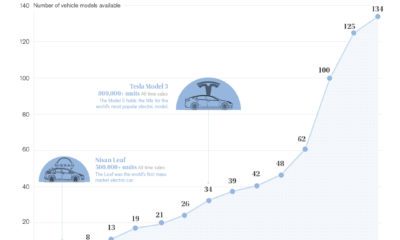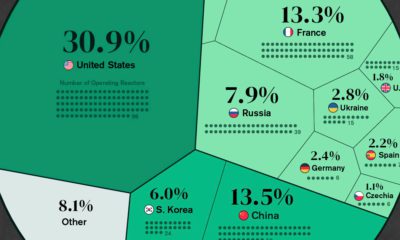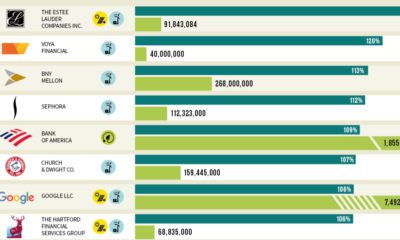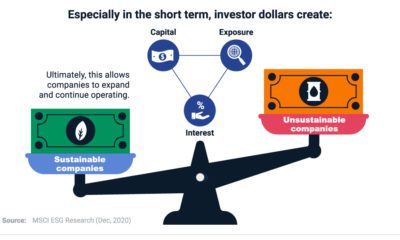The Earth’s growing waste problem can be traced back to a culture that treats virtually every item we buy and own as disposable. Rapid urbanisation, population growth, and industrialisation are key contributors to the burgeoning volumes of waste that humans are producing each year. But what if there was away to get around that?
Introducing the Circular Economy
Today’s post from BlackRock highlights the key benefits of adopting a circular economy, and examines the factors that will make the biggest impact in the years to come.
A Culture of Consumption
Mass production is making products cheaper, more readily available, and more readily disposable, bringing levels of material comfort unimaginable to previous generations. Companies are making new products at a frenetic pace to keep up with global demand─consuming finite resources as if the Earth had an infinite supply. The intense effects of this mass consumption are visible across multiple industries:
Construction: Construction waste alone is expected to reach 2.2 billion tonnes annually by 2025. Fast Fashion: Roughly 87% of clothing is discarded or burned each year, costing US$100 billion. Plastics: Over 95% of plastic packaging value is wasted every year, costing up to US$120 billion.
As natural resources decline and waste continues to pile up, our society is at a crossroads.
A Tale of Two Economies
Today, most of the world follows the Take-Make-Waste practices of the linear economy, with little regard for future use of these resources and products. Unfortunately, most of this ends up in landfills─by 2050, we could be producing 3.4 billion tonnes of waste each year. The circular economy, by contrast, is focused on redesigning our systems, processes, and products to enable goods to be used longer, repurposed, or recycled more efficiently. —BlackRock Companies and governments that choose to adopt a circular economic model could end up saving €600 billion (US$663 billion) annually─and potentially add €1.8 trillion (US$2 trillion) in additional benefits to Europe’s overall economy.
Designing a Better Future
Three major factors are driving the gradual, global shift to a circular economy. While few public companies today are actively using a circular economy, several major brands are leading the way in sustainable business practices.
Philips: Light-as-a-service that provides access to lighting rather than ownership of lightbulbs Levi Strauss: Repurposing old garments into building insulation, upholstery, and new clothing Toshiba: First multi-function printer, heat-sensitive erasable toner can do up to five reprints per page Renault: Revamped old vehicle drive trains, engines, and gearboxes to almost-new condition
Companies and governments in the circular economy have a structural advantage to solve some of the world’s biggest economic issues ─ giving them a strong, long-term market for goods and services, the potential to lower costs, and open profitable new business streams.
Lasting Impact on People, Planet, and Profit
In order for the circular economic model to achieve widespread adoption, both sustainable investment and partnerships across sectors are needed. This rally for change is making an impact on financial markets─sustainable investments around the world grew from US$13.3 trillion in 2012 to US$30.7 trillion in 2018. Healthy economies rely on a healthy environment, and building a circular economy is integral to the future health of our economy, planet, and society. on Over recent decades, farmers have been able to more than double their production of crops thanks to fertilizers and the vital nutrients they contain. When crops are harvested, the essential nutrients are taken away with them to the dining table, resulting in the depletion of these nutrients in the soil. To replenish these nutrients, fertilizers are needed, and the cycle continues. The above infographic by Brazil Potash shows the role that each macronutrient plays in growing healthy, high-yielding crops.
Food for Growth
Nitrogen, phosphorus, and potassium (NPK) are three primary macronutrients that are the building blocks of the global fertilizer industry. Each plays a key role in plant nutrition and promoting crop growth with higher yields. Let’s take a look at how each macronutrient affects plant growth. If crops lack NPK macronutrients, they become vulnerable to various stresses caused by weather conditions, pests, and diseases. Therefore, it is crucial to maintain a balance of all three macronutrients for the production of healthy, high-yielding crops.
The Importance of Fertilizers
Humans identified the importance of using fertilizers, such as manure, to nourish crops dating back to nearly 6,000 to 2,400 BC. As agriculture became more intensive and large-scale, farmers began to experiment with different types of fertilizers. Today advanced chemical fertilizers are used across the globe to enhance global crop production. There are a myriad of factors that affect soil type, and so the farmable land must have a healthy balance of all three macronutrients to support high-yielding, healthy crops. Consequently, arable land around the world varies in the amount and type of fertilizer it needs. Fertilizers play an integral role in strengthening food security, and a supply of locally available fertilizer is needed in supporting global food systems in an ever-growing world. Brazil is one of the largest exporters of agricultural goods in the world. However, the country is vulnerable as it relies on importing more than 95% of its potash to support crop growth. Brazil Potash is developing a new potash project in Brazil to ensure a stable domestic source of this nutrient-rich fertilizer critical for global food security. Click here to learn more about fertilizer and food production in Brazil.

